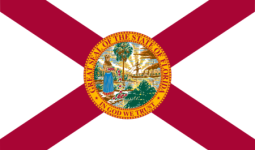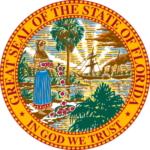Florida
Florida is a state in the southeastern region of the United States, bordered to the west by the Gulf of Mexico, to the north by Alabama and Georgia, to the east by the Atlantic Ocean, and to the south by the Straits of Florida.
- ABBREVIATION: FL
- NICKNAME: The Sunshine State
- POPULATION: 19,552,860 (2013 est.)
- CAPITAL: Tallahassee
- STATE BIRD: Mockingbird
- STATE FLOWER: Orange Blossom
- AREA: 65,755 sq. mi.
- TIME ZONE: – Peninsula and “Big Bend” region Eastern, – Panhandle west of the Apalachicola River Central
- ENTERED UNION: Mar. 3, 1845
- ALTITUDE: High, 345 ft. Britton Hill
- CLIMATE: Hot humid summers, mild winters with occasional frost. Southern tip tropical. Heavy rains during hurricane season.


A 400 mile long peninsula with a coastline of nearly 1200 miles, Florida has baffled men for more than four centuries-beginning with Juan Ponce de Leon, the Spaniard who landed here in 1513 and thought he was on an island. Though it lies entirely north of the Tropic of Cancer, Florida’s tip has a tropical climate. The terrain varies from gently rolling, pine-covered hills in the north to the luxuriant, steaming Everglades in the south, where giant orchid plants sometimes live for hundreds of years. Around the peninsula’s periphery, sand bars, coral reefs and keys are slowly creating new land out of the ocean.
The early colonists were dismayed by this beautiful, balmy region. It had no precious metals; the land could not provide adequate food; and they believed no white man was safe from the hostile Indians. After a slow, almost torpid development, the state underwent great changes at the beginning of the 20th Century, with the building of railroads and the draining of parts of the Everglades. Today, many square miles of the once, believed to be useless, swamps produce a variety of vegetables, notably sweet corn and snap beans. Farther north, citrus fruits thrive.
Rich deposits of phosphate-an important component of fertilizer-have been found in central Florida; these deposits supply most of the needs of the U.S., as well as enrich the soils of Florida itself. Phosphate also nurtures the grass which has helped make Florida an important producer of beef. The state raises a breed of Brahman hybrid cattle that is resistant to heat and many kinds of pests.

Above all else, Florida has found fortune in the vast number of people attracted by its climate. Every year throngs of people flock to Florida to vacation, fleeing the intemperate winters of the north, and a multitude of elderly people seeking-if not Ponce de Leon’s Fountain of Youth-at least a warm and comfortable “Isle of Flowers” for their quiet retirement years.
FUN FACTS:
- Clearwater has the highest rate of per capita lightning strikes of any U.S. city.
- Ft. Lauderdale has 185 miles of local waterways, earning it the nickname of ‘Venice of America’.
- The Overseas Highway, which spans 113 miles between Key Largo and Key West, has more than 42 bridges and links more than a hundred islands. The longest is the Seven Mile Bridge.
- Counting bays and barrier islands along its Atlantic and Gulf coasts, Florida has 8,500 miles of shoreline. Alaska is the only state with more.
- The oldest European settlement in North America is Saint Augustine.
- Citrus fruits originated in Southeast Asia. Ponce de Leon planted the first citrus in Florida in the mid-1500’s.
